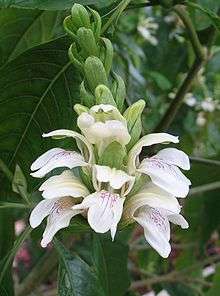Justicia adhatoda
| Justicia adhatoda | |
|---|---|
 | |
| Scientific classification | |
| Kingdom: | Plantae |
| Order: | Lamiales |
| Family: | Acanthaceae |
| Genus: | Justicia |
| Species: | J. adhatoda |
| Binomial name | |
| Justicia adhatoda L. | |
| Synonyms | |
| |
Justicia adhatoda, commonly known in English as Malabar nut, adulsa, adhatoda, vasa, or vasaka,[1][2] is a medicinal plant native to Asia, widely used in Siddha Medicine, Ayurvedic, homeopathy and Unani systems of medicine.[3]
The plant's range includes Sri Lanka, Nepal, India, Pakistan, Indonesia, Malaysia, and China, as well as Panama where it is thought to have been introduced.[3]
Botanical description
Justicia adhatoda is a shrub with lance-shaped leaves 10 to 15 centimeters in length by four wide. They are oppositely arranged, smooth-edged, and borne on short petioles.[4] When dry they are of a dull brownish-green colour. They are bitter-tasting. When a leaf is cleared with chloral hydrate and examined microscopically the oval stomata can be seen. They are surrounded by two crescent-shaped cells at right angles to the ostiole. The epidermis bears simple one- to three-celled warty hairs, and small glandular hairs. Cystoliths occur beneath the epidermis of the underside of the blade.[5]
The trunk has many, long, opposite, ascending branches, where the bark is yellowish in color. Flowers are usually white and the inflorescence shows large, dense, axillary spikes. Fruits are pubescent, and are with club-shaped capsules.
Chemical composition
The leaves of Adhatoda vasica contains phytochemicals such as alkaloids, tannins, saponins, phenolics and flavonoids.[6] The most important is vasicine, a quinazoline alkaloid.[3] The vasicine yield of the herbage has been measured as 0.541 to 1.1% by dry weight.
Traditional medicine
This shrub has a number of traditional medicinal uses in Siddha Medicine, Ayurvedic and Unani systems of medicine.[3]
Cultural reference
It is the unofficial provincial flower of the Punjab province of Pakistan.
Names
It is also called Adhatoda vasica, which is derived from a former scientific name. It has different names in different languages.[7]
- sinhala: pawatta(පාවට්ටා), agaladara (අගලදාර), adathoda (ආඩතෝඩා).
- Rongmei: Thimpui
- Malayalam: Adalodakam (ആടലോടകം)
- Sanskrit: Sinhapuri, Vasaka (वसाका)
- Hindi: Adosa, Arusha, Rus, Bansa
- Bengali: Adulsa, Bakash,Vasok, বাসক পাতা
- Gujarati: Aradusī, Adulso, Aduraspee, Bansa (અરડૂસી)
- Kannada: Adusogae
- Marathi: Adulsa, Adusa (अडुळसा)
- Oriya: Basanga
- Persian: Bansa
- Punjabi: Bhekkar
- Tamil: Adathodai
- Telugu: Adamkabu, Adampaka, Addasaram (అడ్డసరం)
- Nepali: Asuro, Kalo vasak (नेपाली)
- Mizo: Kawldai
In Garhwali language it is called Basingu it is also used as vegetable but very bitter. According to br Panchuri.
References
- ↑ "Common Names for Malabar Nut (Justicia adhatoda)". Encyclopedia of Life. Retrieved 3 January 2013.
- ↑ Aslam, Mohd; Rais, Sumbul; Alam, Masood; Pugazhendi, Arulazhagan (2013). "Adsorption of Hg(II) from Aqueous Solution Using Adulsa (Justicia adhatoda) Leaves Powder: Kinetic and Equilibrium Studies". Journal of Chemistry. 2013: 1–11. doi:10.1155/2013/174807. ISSN 2090-9063.
- 1 2 3 4 "Facts about for Malabar Nut (Justicia adhatoda)". Encyclopedia of Life. Retrieved 3 January 2013.
- ↑ Kumar, M., Dandapat, S., Kumar, A. and Sinha, M.P., Determination of Nutritive value and mineral elements of five-leaf chaste tree (Vitex negundo L.) and Malabar Nut (Adhatoda vasica Nees), Academic Journal of Plant Sciences, 2013; 6(3): 103-108. http://www.idosi.org/ajps/6(3)13/1.pdf
- ↑ Kumar, M., Dandapat, S., Kumar, A. and Sinha, M.P. Anti-typhoid activity of Adhatoda vasica and Vitex negundo Persian Gulf Crop Protection, 2013; 2(3): 64-75 http://corpprotection.ir/files_site/paperlist/Journal2-3-130906213336.pdf
- ↑ Kumar, M., Kumar, A., Dandapat, S. and Sinha, M. P. Phytochemical screening and antioxidant potency of Adhatoda vasica and Vitex negundo, The Bioscan; 8(2): 727-730, 2013 http://www.thebioscan.in/Journal%20Supplement/82Sup26%20MANOJ%20KUMAR.pdf
- ↑ Dr. K. M. Nadkarni's Indian Materia Medica, Volume 1, Edited by A. K. Nadkarni, Popular Prakashan, Bombay, 1976, pp. 40.
External links
- Adathoda Uses in Siddha Medicine
- MONOGRAPH BY Dr AJAY PADMAWAR
- Flora of Nepal: Justicia adhatoda
- Caldecott, Todd (2006). Ayurveda: The Divine Science of Life. Elsevier/Mosby. ISBN 0-7234-3410-7. Contains a detailed monograph on Justicia adhatoda syn. Adhatoda vasica (Vasa; Vasaka), as well as a discussion of health benefits and usage in clinical practice. Available online at http://www.toddcaldecott.com/index.php/herbs/learning-herbs/342-vasaka
| Wikimedia Commons has media related to Justicia adhatoda. |